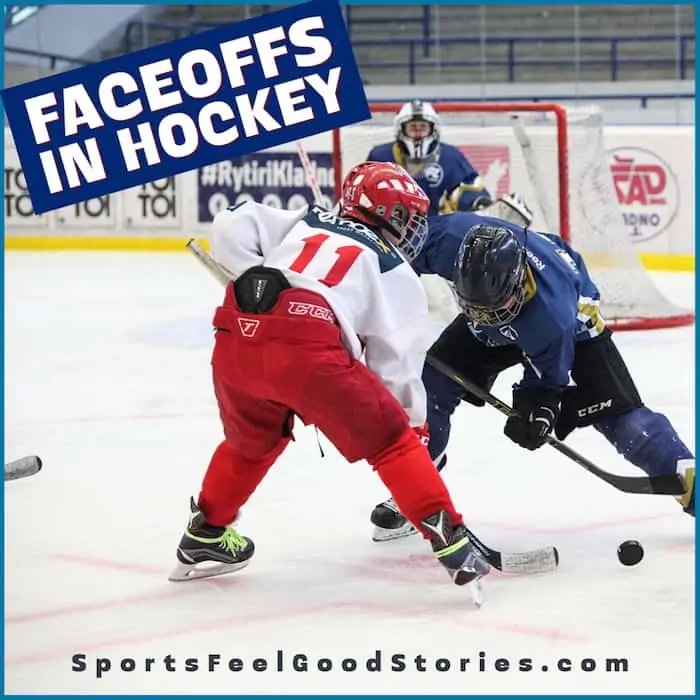A face-off in hockey begins the action. At the start of every game, we watch with great anticipation as the puck is dropped at center ice. Which team will get the first chance to go flying down the ice with the puck? At first glance, a face-off seems pretty straightforward, but as we’re about to find out, it can get a little more complicated.
Face-off Definition
A face-off occurs when two players from each team approach the face-off spot while an official drops the puck. Each player battles with their stick to determine who wins possession of the puck and the play. A face-off starts at the beginning of each period but also after a penalty, or game stoppage, such as if the puck leaves the ice, and after a goal is scored.
Key Takeaways for a Face-off in Hockey
A face-off involves two players facing off against each other while a referee drops the puck.
A face-off occurs in one of the nine spots on the ice after an infraction, a goal, or any other stoppage in play.
Each team wants the player with the best face-off percentage to take the face-off.
There are different strategies in which to approach a face-off.

Different Spots for a Face-off
Center ice is not the only spot where a face-off can take place. If you take a look at the ice rink, you will notice designated face-off spots or dots. There are nine in total. The first is the rink center; there are two more in each attacking zone and two more at each end of the neutral zone.
Each one serves its purpose. The center spot is used to begin each period and after a goal. As for the other eight zones, it depends on the situation. Typically, the four within the neutral zone are used after an unintended offside call has been made.
Otherwise, it may depend on where the puck was stopped. So, if the goalie freezes the puck on the right side of his crease, the face-off will take place at the right face-off dot outside his crease. If, however, intentional offside is the infraction, the face-off can be pulled back to the offending team’s defensive zone.
Lastly, I recently learned while watching a game last night with my husband; a face-off will occur at center ice if there was an error with a call. For the most part, however, face-offs will transpire at the closest face-off dot where the play was stopped.
How Do You Take a Face-off?
Without going into too much strategy, I’ll get into that more later. Let’s understand better how a player takes a face-off. This depends on the location of the face-off. In the attacking zone, he may look ahead to a teammate. In the defensive zone, he may want to clear the puck out from his end.
Let me elaborate further; within the neutral zone, a player may choose to get the puck back to his defensive player so that they can move the puck forward. In the face-off zone, players have to be careful that they don’t get kicked out. Here are a few reasons why this happens.
The first reason he is too quick to enter his body into the circle; the puck hasn’t been dropped yet. Second, his skates aren’t square within the hash lines outside of the dot. Lastly, another player on his team is encroaching too close to the hash marks.
To be kicked out once isn’t a big deal, but a penalty will be called if it happens again. I will admit to not seeing a penalty from being kicked out twice; players are careful not to get this careless penalty. Check out this video below, where Colorado Eagles players explain and demonstrate face-off protocols.
Stick Strategy: Face-off in Hockey
Now, you may notice that one player puts his stick down before the other. But why can’t they put their stick down at the same time? The rules state that it is the player from the visiting team who strikes first, followed by the home team center.
While this may seem like a disadvantage for the home team, it can be quite telling. The home team gains the advantage of looking at the opposing center’s hand position. A hand position can reveal a lot, such as to which way he is trying to win the face-off?
Whether he has a backward or a forward grip, the opposing home team center can adjust his strategy accordingly. The second player may also gain quicker momentum as the visiting center has had his stick in a motionless position for a longer period.
The Face-off Video
Face-off Percentage
Sometimes, when watching a game, stats will flash up on your TV screen. The NHL (and many fans) love to keep track of all kinds of stats, including face-off percentage. This percentage is the rate at which a player wins face-off draws.
Typically, if the rate is above 55%, this player is considered a good face-off contender. During a game, they will also flash the team’s face-off percentage for the game. For example, the Habs have won 67% of all face-offs. They may even include how that team ranks amongst all the 31 teams in the NHL.
Who Takes the Face-off?
In a perfect world, it would be the one with the best face-off percentage. Typically, though, the center player is the designated face-off contender. That said, if there are other great contenders on the team, they will be sent out on the ice during key moments, such as killing a penalty or during a powerplay.
Strategic Styles of a Face-off in Hockey
There are several little tricks of the trade that hockey players have regarding face-offs. First, they make sure to keep their body mass low. This will help to keep their bodies balanced and allow for a quicker reaction to the puck.
Players will tell you that they will have to change their grip from their usual hold to win a face-off with their backhand. Both hands will face back on the stick. They also hold their stick closer to the middle (they choke up on it) to allow for better maneuverability.
A forehand style also requires that the players choke up on their sticks. They also may choose to keep the tip of their stick on the ice. Their grip, however, goes back to a traditional hold where the higher hand faces back and the lower hand faces forward.
The next strategy is a spin move which can be done with both backhand or forehand holds. The player will spin his body into the face-off dot. But some players prefer to avoid the puck altogether and instead go straight for their opponent.
By doing this, it can open the space up for another player on their team to swoop in and steal the puck. The same can be done if the centerman goes for his opponent’s stick directly, trapping him so he cannot reach the puck.
And while the puck can be passed forward, this isn’t likely a move you will as often as they give the puck to the other team’s defensive players. Confused yet? It can be tricky to picture all the different styles, so check out this instructional video to better understand.
How to win Faceoffs Video
The Importance of a Face-off Win
Winning a face-off means possession of the puck. This, in turn, means more chances of scoring a goal. And goals have even been known to come straight off of a face-off win, so to some players, they spend a lot of time strategizing.
Officially, a win is determined by the team that ends up with possession of the puck after it leaves the face-off area. Now, I’ve already shown you a couple of instructional videos, so let’s spice things up with a nice mix of different face-offs styles in some games.
NHL Face-offs Video
Final Thoughts
Some may argue that face-off percentage is irrelevant to a team’s victory but tell that to the goalie who was scored on thanks to a face-off right outside his crease. Regardless of the team’s stats, I believe that the face-off in hockey makes for a more exciting game and demonstrates the players’ skills.

By Danielle L’Ami
Danielle, a Canadian born and raised, was first introduced to hockey by her Tampa Bay Lightning-loving husband back in university. She is a Habs fan. Despite this, they are still together and enjoy watching the rivalry between their two teams each time they play. The victory of the games determines who will get the silent treatment the next day.
Overtime
You’re on our What is a Face-off in Hockey page.
You might like:
Inspirational Slogans for Hockey
